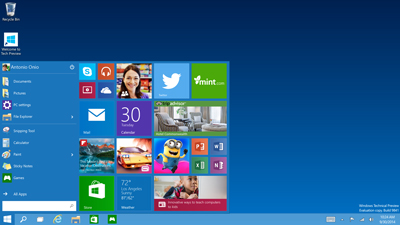News
'Threshold' Is Officially Windows 10, Will Run on PCs and Smartphones
- By Kurt Mackie
- September 30, 2014
Bucking expectations, the next version of the Windows operating system will be called "Windows 10," not "Windows 9," Microsoft announced on Tuesday.
Terry Myerson, executive vice president of Operating Systems at Microsoft, gave the news during a press event in San Francisco. The event included a look at build 9841 of Windows 10.
Microsoft had been using the internal code name of "Threshold" to describe its next Windows under development, and many thought that Threshold would become "Windows 9." However, Myerson said during the event that "it wouldn't be right to call it Windows 9," according to The Verge's live blog (a stream was not available). Microsoft has not given any explanation for the apparent version skip.
The final Windows 10 product will ship in 2015 "later in the year," according to The Verge's live blog. Myerson said that a "Windows Insider Program" will kick off on Wednesday for early testers. A technical preview build will be available for desktops and laptops, followed by one for servers.
Microsoft isn't talking about the pricing of Windows 10 yet. It had been rumored that Windows 9 would be a free upgrade, but that may have turned out to have been a joke, since Windows 9 doesn't exist.
Microsoft confirmed during a Q&A session that Windows 10 would also be the next version of Microsoft's OS for smartphones, and not just an OS for desktops, tablets and laptops. Microsoft's idea is to have common code to support developer efforts on the Windows platform.
Myerson promised that Windows 10 "will run on the broadest types of devices ever" and that it will be "our most comprehensive platform ever." He also claimed that companies would be familiar with Windows 10 and that it "will be compatible with all the traditional management systems used today," according to The Verge.
During the Q&A, an official said that Microsoft built Windows 10 to support existing apps. In addition, Windows 10 is being groomed to support existing devices, according to the Q&A.
Joe Belfiore, corporate vice president of the Operating Systems Group at Microsoft, showed off the new Start Menu in Windows 10 that Microsoft had promised in its past events to bring back. The new Start Menu looks like a conglomeration of the Windows 7 Start Menu and a collection of pinned Live Tiles from the Windows 8 Start Screen. The tiles on the new Start Menu can be resized, according to Belfiore. The Start Menu also has a "universal search" capability that shows results for Windows 10 and the Web.
 [Click on image for larger view.]
Windows 10 Start Menu. (Source: Microsoft)
[Click on image for larger view.]
Windows 10 Start Menu. (Source: Microsoft)
Belfiore characterized the new Start Menu as a blend of OS elements.
"The tiles and icons that are shown are a blend of classic apps and new universal apps," Belfiore explained, according The Verge.
The term "universal apps" apparently is a new Microsoft descriptor for what used to be called "metro" apps (also known as "modern apps" or "Windows Store apps"). These universal apps apparently are the kind of apps that run full screen on the Windows Store Apps side of Windows 8, although Myerson said that Microsoft would share more about the universal apps concept at its Build developer conference in April. Microsoft did publish this blog post on Tuesday that talks a little more about the universal apps concept.
Windows 10 will allow both "classic" Windows 7 apps and universal apps to have Snap capability, which will let two apps appear side by side on the screen. Windows 10 will support up to four snapped apps on a screen. Microsoft is also running all apps in the same windowed format in Windows 10, both Windows Store Apps and metro apps. The windows can be resized and moved, and they have title bars.
Microsoft also added a new button on the taskbar of Windows 10 called the "task view." It will surface a particular screen view with multitasked apps. Previously, this feature was rumored to be called "virtual desktops," a feature seen in Linux-based operating systems such as Ubuntu. With the task view feature in Windows 10, it's possible to have quick access to multiple desktops. Belfiore called this feature "world changing," according to The Verge.
Microsoft even improved the old command prompt in Windows 10. It's now possible copy a directory path right into the command prompt window using Control+V keys instead of having to use the command prompt's menu to perform such a paste operation.
Windows 10 users who depend on touch will still get the old Charms bar (rumor had said Microsoft planned to eliminate it). However, Microsoft added access to a task view menu in Windows 10 when swiping from the left, according to The Verge.
Microsoft pointed to this video, which shows Belfiore demonstrating Window 10. Microsoft's announcement showing Windows 10 screenshots can be found here.
About the Author
Kurt Mackie is senior news producer for 1105 Media's Converge360 group.